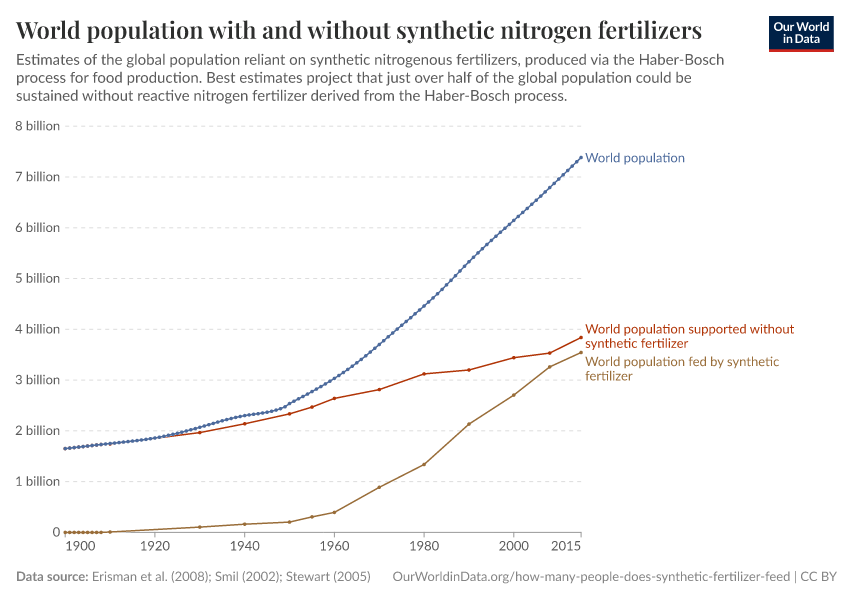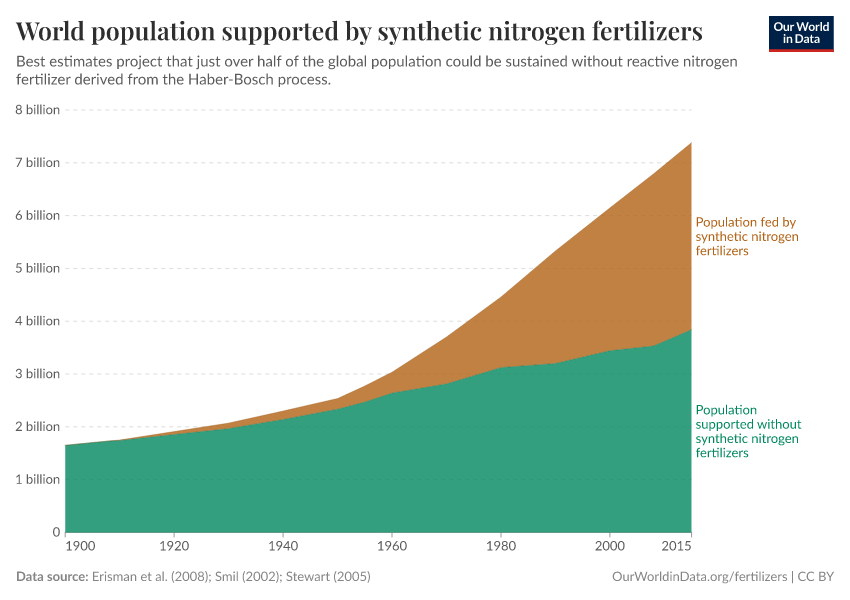How many people does synthetic fertilizer feed?
Predictions of a global food crisis — that the world's food production would not be able to keep pace with population growth — have a long history. In the 18th century the English cleric Thomas Robert Malthus hypothesized that gains in per capita resources would inevitably be outstripped by population until food supplies finally acted as a barrier to further growth.1
Such predictions have continued well into the 20th and 21st centuries; in his controversial 1968 book The Population Bomb, Paul Ehrlich argued that global population would continue to grow until the point of mass starvation.2
Both Malthus and Ehrlich should be surprised to see the current state of the world. Today, we can support a global population of around 7.4 billion (and growing), with many consuming far in excess of requirements.3
There are a number of scientific and technological innovations which have allowed for rapid growth in crop productivity, particularly in the second half of the 20th century. None of these had a more dramatic impact than the ability to produce synthetic nitrogen fertilizer.
In fact, it's estimated that nitrogen fertilizer now supports approximately half of the global population. In other words, Fritz Haber and Carl Bosch — the pioneers of this technological breakthrough — are estimated to have enabled the lives of several billion people, who otherwise would have died prematurely, or never been born at all.4
It may be the case that the existence of every second person reading this attributes back to their 20th century innovation.
Atmospheric alchemy: making fertilizer from air
Understanding the significance of nitrogen fertilizer requires a brief explanation of its role in global crop production. In addition to water and sunlight, crops need three key nutrients to grow: nitrogen, phosphorous and potassium. Nitrogen is often the nutrient that is limiting to further crop production, despite Earth's atmosphere containing more than 78 percent. This is because in the atmosphere, nitrogen exists in its largely unreactive N2 form, rather than in a reactive form which plants can utilize.
For millennia, agricultural crop had to rely on the limited quantity of reactive nitrogen which was naturally occurring in soils and ecosystems.5
This remained the case until 1908 when the German chemist Fritz Haber developed a process by which atmospheric N2 could be converted into ammonia (NH3) – a form of reactive nitrogen which plants can use.6
Carl Bosch, another German chemist and engineer, was able to take Fritz Haber's laboratory-scale process and develop it at an industrial scale. The combined "Haber-Bosch process" remains the primary industrial method for the production of synthetic nitrogen fertilizer.
How many people does nitrogen fertilizer feed?
In simple terms, crops typically respond positively to nutrient inputs. As we explore in detail in our entry on Crop Yields, crop yields and fertilizer application typically show a strong positive relationship. Fertilizer application, combined with other productivity factors such as improved crop varieties, genetic breeding, irrigation and mechanization led to a significant inflection in crop yield trends across the world in the 20th century. It should be noted that this growth in agricultural output — from both industrial and organic farming — has undoubtedly resulted in important ecological and resource pressures. However, as we cover in detail in a recent blog post, organic farming (that is, agriculture without synthetic inputs) can often have a greater environmental impact than conventional agriculture.
So, how many people does synthetic nitrogen fertilizer actually feed? Below we draw upon several published estimates, which tend to converge on a similar share of the global population. Results published by Erisman et al. (2012) in the scientific magazine Nature are shown in the chart.7
These results also tie closely with Vaclav Smil's widely-quoted estimates, which we discuss later.8
- In the chart we see the actual global population trend as the top line — growing from around 1.65 billion in 1900 to almost 7.4 billion in 2015.
- The bottom line represents estimates of the number of people fed by synthetic nitrogen fertilizers. As we see, nitrogen fertilizers only became available following the commercialization of the Haber-Bosch process from 1910 onwards. Since then, Erisman et al. estimate it has supported 42 percent of global births over the past century. This amounts to 44 percent of the global population in 2000 being fed by nitrogen fertilizers, rising to 48 percent in 2008. Here we have extended this estimate to 2015 with the continuation of the assumption that 48 percent of the global population are fed by nitrogen fertilizers. Since the share supported by the process continues to rise, this may in fact be a conservative estimate. This means that in 2015, nitrogen fertilizers supported 3.5 billion people that otherwise would have died.
- The middle line represents the size of the global population which would therefore be supported without the use of nitrogenous fertilizers. This is shown simply as the actual population minus the number of people reliant on them for food production. Without this innovation, global population may have been reduced to only 3.5 to 4 billion people.
How can we estimate the number of people fed?
Firstly, it's important to note that these estimates are understandably difficult to derive with a high degree of certainty. This difficulty arises for several reasons. Notably there have been a number of additional contributors to productivity gains in agriculture throughout the 20th and 21st centuries, including crop breeding, irrigation, mechanization, and farm management techniques — untangling the individual role of nitrogen fertilizers alone is challenging. Secondly, the global food system is complex and geographically highly unequal: high-income countries have moved beyond the stage of aiming to meet basic nutritional requirements from food production, and now dedicate a large share of food production to meat (which is a much less efficient nitrogen converter) and bioenergy production.9
Nonetheless, general estimates tend to converge on a figure in the range of 40-50 percent of the population. Let's look at three widely cited estimates:
- Utilizing a range of long-term evaluations, spanning a total of 362 seasons of crop production, of crop yields and nutrient budgets across the world, Stewart et al. (2005) concluded that between 30-50 percent of yield increases could be attributed to synthetic fertilizer inputs (and typically even higher in the tropics).10
- Smil (2004) reached similar conclusions, suggesting with high confidence that global crop harvests would be approximately half of current levels without nitrogen fertilizer inputs.8 Vaclav Smil derives his calculations based on the use of nitrogen crop, livestock and human protein (of which the building blocks are nitrogen) balances. His nitrogen balance concluded that 85 percent of all nitrogen in food protein for humans is derived from cropland; the remainder came from seafood or livestock on grazing land. Since nitrogen fertilizer provided around half of the nutrient in this harvested crop, he estimated that it provided 40 percent of dietary protein in the mid-1990s. He concluded that 40 percent of the global population in 2000 were dependent on food production from synthetic fertilizers.
- Erisman et al. (2012) have since updated these estimates to the year 2008, estimating a similar (but slightly higher) share of 44 percent in 2000 and 48 percent in 2008.
The complexities of the global food system make it challenging to provide a firm figure, however, it's likely that just under half of the global population is dependent on synthetic nitrogen fertilizers. This is further shown in the chart. As a result, the Haber-Bosch process will likely have enabled the lives of at least 3 to 3.5 billion people today.
Endnotes
Malthus (1798). An Essay on the Principle of Population: Or, A View of Its Past and Present Effects on Human Happiness; with an Inquiry Into Our Prospects Respecting the Future Removal Or Mitigation of the Evils which it Occasions. J.Johnson. London. Later edition available online.
Ehrlich, P. R. (1997). The Population Bomb (1968). New York: Sierra Club/Ballantine.
It is also true that around 815 million people were undernourished in 2016. However, as is often the case with food insecurity and famine, this is largely attributed to sociopolitical, stability and economic factors rather than an inability to produce enough food.
See also this BBC programme.
Legumes are the one exception to this condition. Legumes — such as peas, beans and other pulses — have the unique ability of being able to convert atmospheric N2 into reactive nitrogen, which can then be used for crop growth.
Reay, D. (2015). Nitrogen and Climate Change: An Explosive Story. Palgrave Macmillan. ISBN 978-1-137-28696-3.
Erisman, J. W., Sutton, M. A., Galloway, J., Klimont, Z., & Winiwarter, W. (2008). How a century of ammonia synthesis changed the world. Nature Geoscience, 1(10), 636-639. Available online.
Smil, V. (2004). Enriching the Earth: Fritz Haber, Carl Bosch, and the Transformation of World Food Production. MIT Press. ISBN: 9780262194495.
A global estimate therefore hides these inequalities; it may be the case that less than 48 percent of the population in high-income countries rely on nitrogen fertilizer to meet basic food requirements, whereas this share is higher in lower-income nations.
Stewart, W. M., Dibb, D. W., Johnston, A. E., & Smyth, T. J. (2005). The contribution of commercial fertilizer nutrients to food production. Agronomy Journal, 97(1), 1-6. Available online.
Cite this work
Our articles and data visualizations rely on work from many different people and organizations. When citing this article, please also cite the underlying data sources. This article can be cited as:
Hannah Ritchie (2017) - “How many people does synthetic fertilizer feed?” Published online at OurWorldinData.org. Retrieved from: 'https://ourworldindata.org/how-many-people-does-synthetic-fertilizer-feed' [Online Resource]BibTeX citation
@article{owid-how-many-people-does-synthetic-fertilizer-feed,
author = {Hannah Ritchie},
title = {How many people does synthetic fertilizer feed?},
journal = {Our World in Data},
year = {2017},
note = {https://ourworldindata.org/how-many-people-does-synthetic-fertilizer-feed}
}Reuse this work freely
All visualizations, data, and code produced by Our World in Data are completely open access under the Creative Commons BY license. You have the permission to use, distribute, and reproduce these in any medium, provided the source and authors are credited.
The data produced by third parties and made available by Our World in Data is subject to the license terms from the original third-party authors. We will always indicate the original source of the data in our documentation, so you should always check the license of any such third-party data before use and redistribution.
All of our charts can be embedded in any site.

